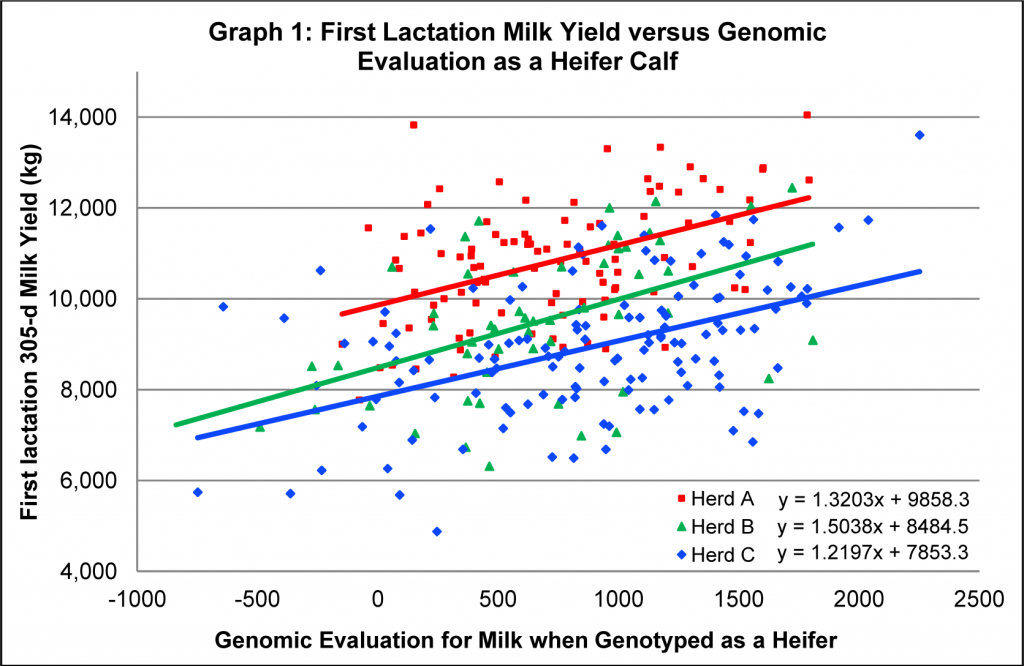 Over the past few years, we’ve seen many examples of the benefits of genomics on the sire side. Quantifying the advantages of genomic selection on the female side has been slower, primarily due to the cautious adoption of the technology at the herd level. Of the registered Holstein heifers born in Canada in 2013, less than 5% were genotyped. On the other hand, CDN projections show that uptake could increase to surpass the 18% mark by year 2020.
Over the past few years, we’ve seen many examples of the benefits of genomics on the sire side. Quantifying the advantages of genomic selection on the female side has been slower, primarily due to the cautious adoption of the technology at the herd level. Of the registered Holstein heifers born in Canada in 2013, less than 5% were genotyped. On the other hand, CDN projections show that uptake could increase to surpass the 18% mark by year 2020.
With genomic testing, producers have the opportunity to improve the genetic potential of their herd and decrease costs. This can be done by capitalizing on the herd’s best genetics through the use of sexed semen, flushing or IVF, or by selling the bottom end, breeding them with beef semen or using them as recipients.
Genomic Tested Heifers and First Lactation Performance
Does a heifer’s first genomic prediction provide enough information about future performance to allow confidence in selection and culling decisions at an early age? To answer this question, we examined three Canadian commercial herds that extensively genotyped heifers born in 2011. These animals were chosen since they have had the chance to complete their first lactation and be type classified.
Graph 1 compares the first genomic evaluation for milk yield (GPA Milk) after being genotyped as a heifer calf to the subsequent first lactation 305-day milk production. In total, the chart includes 305 cows born in 2011 from the three herds. Average 305-day milk yield was highest for Herd A, followed by Herd B, and was the lowest for Herd C. In general, within all three herds, the higher the GPA Milk as a heifer calf, the higher the first lactation 305-day milk yield as a cow. This clearly demonstrates the usefulness of genomic evaluations for heifers as a tool for identifying the animals that will perform better in your herd as a cow.
Graph 1 also shows the equations for predicting the first lactation 305-day milk yield in kilograms based on the genomic evaluation as a heifer. While the prediction is not perfect, on average 1 kg increase in GPA Milk resulted in a first lactation milk yield gain of 1.2 to 1.5 kg, depending on the herd. This exceeds the expectation of one kg milk yield per one kg of GPA Milk and presumably results from appropriate management in each herd. The actual yield per kg GPA Milk can be used to gauge whether the management level in a given herd is fully taking advantage of the herd’s genetic potential. If the management level wasn’t taking full advantage of the herd’s genetic potential, we’d expect the actual ratio of milk yield to GPA Milk to be less than one.
GPA LPI and First Lactation Performance
Is a higher genomic evaluation as a heifer calf associated with better first lactation performance? To answer this question the three herds studied above were analyzed separately and their data was subsequently combined to create Table 1. In total, 284 animals with a lactation and classification in first lactation were included in the analysis. These animals were divided into four groups of 71 cows based on their genomic evaluation for LPI as a heifer (GPA LPI). Table 1 compares the actual first lactation performance for production and type for the highest versus the lowest 25% of these animals based on GPA LPI.
The heifers that ranked within the top 25% for GPA LPI in their herd performed better in first lactation on nearly all accounts relative to the bottom quartile. As cows, the heifers that were in the top quartile for GPA LPI produced more milk, fat and protein, and scored higher at first classification for final score, mammary system and feet & legs than those in the bottom quartile. Categorizing heifers into the top and bottom quartiles based on their genomic LPI resulted in no significant difference in the average somatic cell count as cows in first lactation.

What Does This Tell Us?
These findings validate that heifer calf genomic evaluations can be an indicator of future performance. In addition, they confirm that genotyping heifer calves at a young age can provide producers with useful information for making selection and culling decisions. Lastly, these results show that genomic LPI values for heifers can be used as primary selection criteria as they are related to first lactation performance for both production and conformation traits.
Authors: Lynsay Beavers and Brian Van Doormaal, CDN
Date: May 2014










